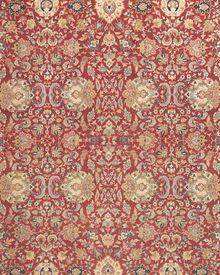Pakistani Carpet
Pakistani carpet or Pakistani rug is one of the eastern rugs that woven in Pakistan.
Pakistan country bordered by India, Afghanitan, and Iran. Pakistan was formerly a part of India and became independent with the partition of India in 1947. It comprises the states of Sind, Punjab, Baluchistan, Northwest Frontier Province, and part of Kashmir. About 77% of the population is Sunni and 20% is Shi’ia. Virtually all contemporary pile rugs woven in Pakistan are intended for export. Until recently, rug designs were copies of or variations of Turkmen models (“Bohkara” designs). Now, some copies of Persian rugs are woven. Rug weaving centers are Lahore, Karachi, Hyderabad, and Peshawar. Rug weaving in Pakistan is organized as both factory and cottage production.
Rugs of Pakistan are woven on a cotton foundation with the asymmetric knot. The cheapest grades may have jute wefts. Wools are local or blended with New Zealand or Australian wool for the finer grades of rugs. Where designs copy Persian models, offset warps are used, while warps are not offset for the “Bokhara” designs. Knot densities for Pakistani rugs are expressed as: (knots per horizontal inch)/ (knots per vertical inch). Thus, 11/22 equals 11 x 22 or 242 knots per square inch.
The term “doubles” in referring to knots of Pakistani rugs means that the vertical knot count is twice the horizontal knot count. Pakistani rugs have knot densities ranging from 40 to 350 knots per square inch. Wool flatweaves are produced in Pakistan for domestic use. These are termed “farrasie” and “palesk.”[1]
| Pakistani Carpet | |
|---|---|
 | |
| General information | |
| Name | Pakistani Carpet |
| Original name | فرش پاکستان، قالی پاکستان |
| Alternative name(s) | Pakistani Rug |
| Origin | |
| Technical information | |
| Pile material | Wool, Silk |
| Foundation material | Cotton, Wool, Silk |
| Knot type | Asymmetrical (Persian) |
History
Pakistan is a country located in South Asia, bordered by India in the east, the Arabian Sea in the south, Iran (Persia) and Afghanistan in the west, and China in the northeast. Pakistan was once part of Greater India until its independence in 1947.
Pakistan's weaving heritage traces back to the Mughal reign of Emperor Akbar the Great (r. 5556— 1605). Fine carpets with Persian designs were woven in the city of LAHORE. Many Lahore carpets from the Mughal era are preserved in museums and private collections around the world today. Important carpets were also produced in the city of Multan, formerly in India, during the Mughal period.
By the nineteenth century, weavers were making carpets in Bannu, Kohat, Peshawar, and the surrounding areas under the British Raj. Carpets woven with Persian floral designs were produced under the supervision of foreign companies in large quantities.
After Pakistan's independence the carpet industry grew dramatically. Many cities and provinces, especially Karachi, actively produced carpets for world-wide export. Pakistani carpets were manufactured with mostly Persian or Bukhara designs in several grade qualities. This carpet revolution in Pakistan had a significant positive impact on the economy of the newly independent country.
Pakistani weavers use wool or cotton for the foundation and a wool pile. A small percentage of carpets with a silk foundation and a silk pile are also manufactured. The Persian (asymmetric) knot is used. The weavers utilize a broad range of colors for the backgrounds, borders, and design elements. Formats range from small bag face rugs to large room-size carpets. Runners and gallery sizes are also made.
Today Pakistan has become an important carpet exporter worldwide. Carpet manufacturers here make a variety of designs and grade qualities to meet market demand.[2]
References
Bibliography
- Abraham Levi Moheban. 2015. The Encyclopedia of Antique Carpets: Twenty-Five Centuries of Weaving. NewYork: Princeton Architectural Press.
- Peter F. Stone. 2013. Oriental Rugs: An Illustrated Lexicon of Motifs, Materials, and Origins. North Clarendon: Tuttle.